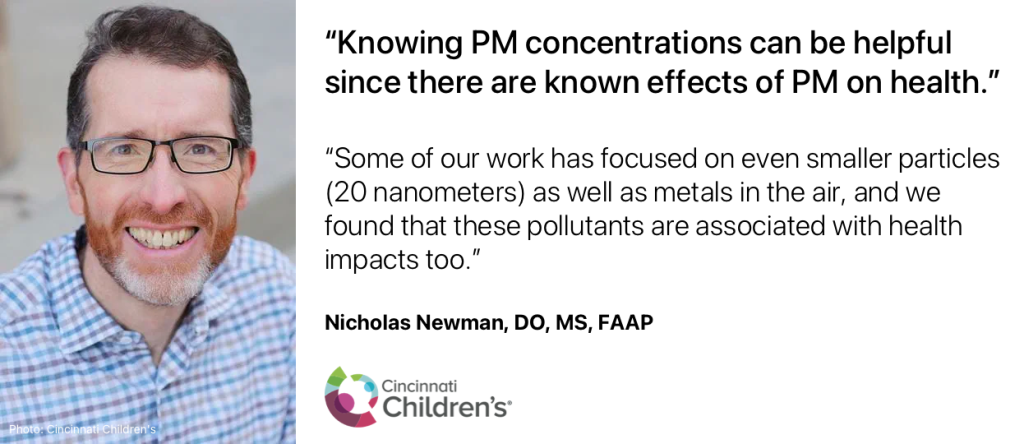The Local Haze team recently spoke with Dr. Nicholas Newman, a Physician-Researcher in Cincinnati, Ohio, USA whose work is focused on providing care to children exposed to environmental toxicants and children with special health care needs.

An MIT alum, Dr. Newman recently contacted the Local Haze team after an MIT Alumni group webinar titled “EESN: New Air Monitoring for Tracking Health and Energy Benefits” held during the summer of 2023. The Local Haze team participated in the panel hosted by the MIT Alumni Energy, Environment and Sustainability Network.
Given his work on the impact of air quality on pediatric health, we asked Dr. Newman to tell us a bit about his work as an Associate Professor of Pediatrics at the Department of Environmental and Public Health Sciences at the University of Cincinnati and to share his thoughts about air quality monitoring.
Thank you for joining us today. A theme of your work on the physical environmental effects on human health has been on the awareness within the medical profession. How do you see the wider community awareness of the environmental impacts on health as opposed to issues such as diet?
This is a really good question. There are members of the general public who are much more concerned about and more informed about environmental exposures than many healthcare providers. On the other hand, sometimes members of the public are very concerned about exposures that science has determined to be quite safe, but aren’t aware of the impact of really common exposures, like air pollution. One of the challenges has been to figure out how to integrate environmental health into health care provider education since the curriculum is so “full” as it is.
You have been examining the impact of environmental pollution on health during early human development. Are you seeing that there are critical ages where the impact is significantly more than others? Or that after some point humans become much less sensitive?
True, the impact of environmental pollution varies by age. When looking at our studies of environmental pollution, specifically air pollution, we are seeing the biggest impacts during pregnancy and in the first few years of life. The brain and many other organs are still developing and are extremely sensitive during this time period.
The environmental impact on health is usually characterized over a long term (months to years). Have you seen anything suggesting short-term exposure (minutes to hours) might be just as impactful?
Air pollution is a very good example of this. For example, researchers at the University of Washington found that following high exposure to wildfire smoke – as was seen in the Midwest and East Coast in the summer of 2023 and annually in the West and Pacific Northwest – there was a 7% increase in all cause hospital admissions for children. This suggests that these relatively short exposures can have significant effects on health. We need more data on the relationship between short-term exposures and health effects however.
Due to the relative amount of time that we all spend indoors, a lot of your characterization of environmental pollution has been indoor-focused. How do you see the relative impact of outdoor conditions?
Part of indoor air pollution is made up of outdoor air pollution that has “penetrated” the building. Therefore, cleaning up the indoor air also requires monitoring the outdoor air. Our group studied children at risk for increased traffic-related air pollution. We found that for children with poorly controlled asthma, reducing the particulate matter in the home improved their asthma control and quality of life scores. This makes me hopeful that we can do something to help kids who are exposed to higher levels of air pollution.
With the availability of low-cost particulate matter sensors, air pollution is becoming focused on PM concentrations. From a health impact point of view, is this sufficient or should there be more focus on the particulate source and composition? Or even on gaseous pollutants which are not as simple to measure?
Knowing PM concentrations can be helpful since there are known effects of PM on health. Some of our work has focused on even smaller particles (20 nanometers) as well as metals in the air and we found that these pollutants are associated with health impacts too. Since many of these pollutants are found together; however, PM might be a good “surrogate” marker of at least some of these other pollutants.
How can people contact you if they have questions about your work?
People can contact me through the Environmental Health and Lead Clinic at Cincinnati Children’s Hospital
For more information on Dr. Nicholas Newman’s work:
See these research papers and visit the link below:
Nicholas Newman, DO, MS, FAAP
Associate Professor of Pediatrics and Environmental & Public Health Sciences
University of Cincinnati
Director, Environmental Health & Lead Clinic
Cincinnati Children’s Hospital Medical Center
Cincinnati, OH, USA
Photo credit: Cincinnati Children’s Hospital Medical Center